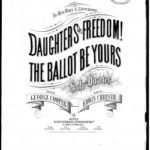The power of nonviolent actions and attitudes as a means to resist oppression and spur reforms is a recurring feature of democratic and democratizing societies. The School Violence Prevention Demonstration Program presents educators with lesson plans that explore the use of nonviolence in history, paying particular attention to the civil rights movement and African American history. Six lessons address: the 1963 Children’s March; the concept of nonviolence using primary sources and stories of participants in the civil rights movement; the power of nonviolence; the story of Rosa Parks; citizenship schools; how music can be used to achieve social and political change.
Constitution: Analyze – Explore – Music
Students will engage in a study of the Constitution to learn about the nature and structure of the United States. The Constitution will be analyzed and discussed as a primary source to understand the form of government and principles of the U.S. This lesson provides students an opportunity to explore how the government works and what the Constitution means to them today. Students will create a song to demonstrate understanding of the Constitution and nature of the U.S. government. Constituting America has a song contest teachers may want to integrate with this lesson plan.
Music Distribution and Copyright
This guided discussion will help students understand copyright law, especially its relevance in this technology-based era. It begins by probing students’ experiences with online media, and eliciting their understanding of copyright. The formal definition can then be presented. A hypothetical copyright conflict between the Jims Brothers and the FrontStreet Boys will illustrate the complexity of copyright law in this technological era.
